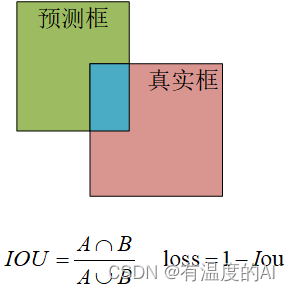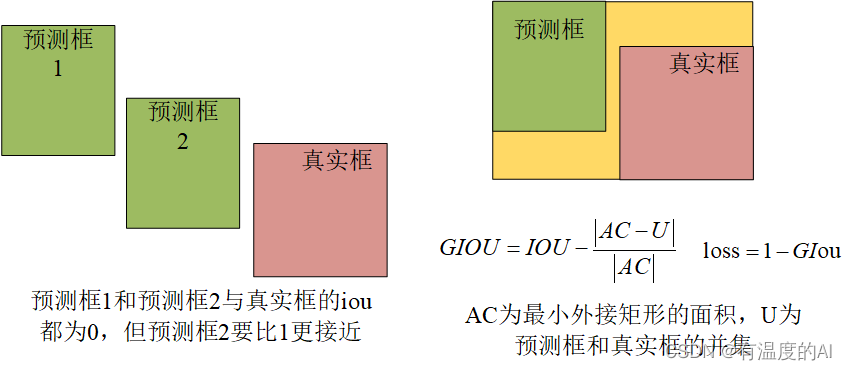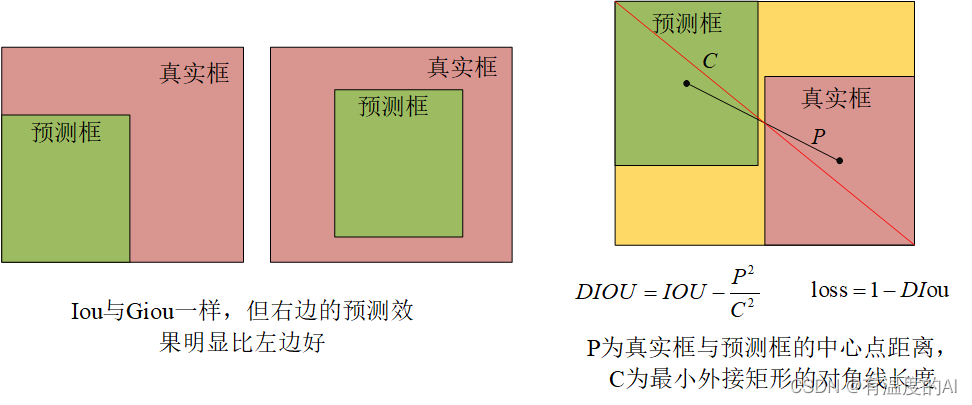一、IOU

def iou(box, boxes):
# box:[x1, y1, x2, y2] 左上角和右下角坐标
# boxes: [[x1, y1, x2, y2], [x1, y1, x2, y2], [x1, y1, x2, y2]....] 包含很多个框
box_area = (box[2]-box[0])*(box[3]-box[1])
boxes_area = (boxes[:, 2]-boxes[:, 0])*(boxes[:, 3]-boxes[:, 1]) #第一个维度全取,第二个维度...
# 求交集
xx1 = torch.maximum(box[0], boxes[:, 0])
yy1 = torch.maximum(box[1], boxes[:, 1])
xx2 = torch.minimum(box[2], boxes[:, 2])
yy2 = torch.minimum(box[3], boxes[:, 3])
# 判断两个框有没有交集,如果xx2-xx1<0,w*h=0
w,h = torch.maximum(torch.Tensor([0]), xx2-xx1), torch.maximum(torch.Tensor([0]), yy2-yy1)
#交集的面积
over_area = w*h
# iou = 交集/并集
return over_area/(box_area+boxes_area-over_area)
if __name__ == '__main__':
box = torch.tensor([1, 1, 7, 7])
boxes = torch.tensor([[1, 1, 10, 10], [4, 4, 7, 7], [3, 3, 6, 6], [2, 2, 7, 7]])
print(iou(box,boxes))
二、GIOU

def Giou(box, boxes):
# box:[x1, y1, x2, y2] 左上角和右下角坐标
# boxes: [[x1, y1, x2, y2], [x1, y1, x2, y2], [x1, y1, x2, y2]....] 包含很多个框
box_area = (box[2] - box[0]) * (box[3] - box[1])
boxes_area = (boxes[:, 2] - boxes[:, 0]) * (boxes[:, 3] - boxes[:, 1]) # 第一个维度全取,第二个维度...
# 求交集
xx1 = torch.maximum(box[0], boxes[:, 0])
yy1 = torch.maximum(box[1], boxes[:, 1])
xx2 = torch.minimum(box[2], boxes[:, 2])
yy2 = torch.minimum(box[3], boxes[:, 3])
# 判断两个框有没有交集,如果xx2-xx1<0,w*h=0
w, h = torch.maximum(torch.Tensor([0]), xx2 - xx1), torch.maximum(torch.Tensor([0]), yy2 - yy1)
# 交集的面积
over_area = w * h
# 求最小外接矩形
xx11 = torch.minimum(box[0], boxes[:, 0])
yy11 = torch.minimum(box[1], boxes[:, 1])
xx22 = torch.maximum(box[2], boxes[:, 2])
yy22 = torch.maximum(box[3], boxes[:, 3])
w, h = xx22-xx11, yy22-yy11
# 最小外接矩形面积
max_area = w * h
return over_area/(box_area + boxes_area - over_area)-((max_area)-(box_area + boxes_area - over_area))/max_area
if __name__ == '__main__':
box = torch.tensor([1,1,7,7])
boxes = torch.tensor([[1,1,10,10], [4,4,7,7], [3,3,6,6], [2,2,7,7]])
print(Giou(box,boxes))
三、DIOU

def Diou(box, boxes):
# box:[x1, y1, x2, y2] 左上角和右下角坐标
# boxes: [[x1, y1, x2, y2], [x1, y1, x2, y2], [x1, y1, x2, y2]....] 包含很多个框
box_area = (box[2] - box[0]) * (box[3] - box[1])
boxes_area = (boxes[:, 2] - boxes[:, 0]) * (boxes[:, 3] - boxes[:, 1]) # 第一个维度全取,第二个维度...
# 真实框中心点x坐标
x1_center = (box[2] - box[0]) / 2 + box[0]
# 真实框中心点y坐标
y1_center = (box[3] - box[1]) / 2 + box[1]
# 预测框中心点x坐标
x2_center = (boxes[:, 2] - boxes[:, 0]) / 2 + boxes[:, 0]
# 预测框中心点y坐标
y2_center = (boxes[:, 3] - boxes[:, 1]) / 2 + boxes[:, 1]
# print(x1_center, y1_center)
# print(x2_center, y2_center)
# 求交集
xx1 = torch.maximum(box[0], boxes[:, 0])
yy1 = torch.maximum(box[1], boxes[:, 1])
xx2 = torch.minimum(box[2], boxes[:, 2])
yy2 = torch.minimum(box[3], boxes[:, 3])
# 判断两个框有没有交集,如果xx2-xx1<0,w*h=0
w, h = torch.maximum(torch.Tensor([0]), xx2 - xx1), torch.maximum(torch.Tensor([0]), yy2 - yy1)
# 交集的面积
over_area = w * h
# 求最小外接矩形
xx11 = torch.minimum(box[0], boxes[:, 0])
yy11 = torch.minimum(box[1], boxes[:, 1])
xx22 = torch.maximum(box[2], boxes[:, 2])
yy22 = torch.maximum(box[3], boxes[:, 3])
P_sqrt = (x2_center-x1_center)**2 + (y2_center-y1_center)**2
C_sqrt = (xx22-xx11)**2 + (yy22-yy11)**2
return over_area/(box_area + boxes_area - over_area) - P_sqrt/C_sqrt
if __name__ == '__main__':
box = torch.tensor([1,1,7,7])
boxes = torch.tensor([[1,1,10,10], [4,4,7,7], [3,3,6,6], [2,2,7,7]])
print(Diou(box,boxes))
四、CIOU

def Ciou(box, boxes):
# box:[x1, y1, x2, y2] 左上角和右下角坐标
# boxes: [[x1, y1, x2, y2], [x1, y1, x2, y2], [x1, y1, x2, y2]....] 包含很多个框
box_area = (box[2] - box[0]) * (box[3] - box[1])
boxes_area = (boxes[:, 2] - boxes[:, 0]) * (boxes[:, 3] - boxes[:, 1]) # 第一个维度全取,第二个维度...
# 真实框宽、高
w_gt = box[2] - box[0]
h_gt = box[3] - box[1]
# 预测框宽、高
w_pr = boxes[:, 2] - boxes[:, 0]
h_pr = boxes[:, 3] - boxes[:, 1]
# 真实框中心点x坐标
x1_center = (box[2] - box[0]) / 2 + box[0]
# 真实框中心点y坐标
y1_center = (box[3] - box[1]) / 2 + box[1]
# 预测框中心点x坐标
x2_center = (boxes[:, 2] - boxes[:, 0]) / 2 + boxes[:, 0]
# 预测框中心点y坐标
y2_center = (boxes[:, 3] - boxes[:, 1]) / 2 + boxes[:, 1]
# print(x1_center, y1_center)
# print(x2_center, y2_center)
# 求交集
xx1 = torch.maximum(box[0], boxes[:, 0])
yy1 = torch.maximum(box[1], boxes[:, 1])
xx2 = torch.minimum(box[2], boxes[:, 2])
yy2 = torch.minimum(box[3], boxes[:, 3])
# 判断两个框有没有交集,如果xx2-xx1<0,w*h=0
w, h = torch.maximum(torch.Tensor([0]), xx2 - xx1), torch.maximum(torch.Tensor([0]), yy2 - yy1)
# 交集的面积
over_area = w * h
# 求最小外接矩形
xx11 = torch.minimum(box[0], boxes[:, 0])
yy11 = torch.minimum(box[1], boxes[:, 1])
xx22 = torch.maximum(box[2], boxes[:, 2])
yy22 = torch.maximum(box[3], boxes[:, 3])
P_sqrt = (x2_center-x1_center)**2 + (y2_center-y1_center)**2
C_sqrt = (xx22-xx11)**2 + (yy22-yy11)**2
# v = (4 / (math.pi ** 2)) * torch.pow((torch.atan(w2 / h2) - torch.atan(w1 / h1)), 2)
n = 4 / (math.pi ** 2)
t = (np.arctan(w_gt / h_gt)-np.arctan(w_pr / h_pr))**2
v = n * t
S = 1 - over_area/(box_area + boxes_area - over_area) # 1-iou
alpha = v / (S + v)
return over_area/(box_area + boxes_area - over_area) - P_sqrt/C_sqrt - alpha*v
if __name__ == '__main__':
box = torch.tensor([1,2,4,10])
boxes = torch.tensor([[1,1,10,10], [4,4,7,7], [3,3,6,6], [2,2,7,7]])
print(Ciou(box,boxes))



